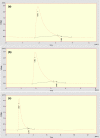Enhanced biogas yield by thermo-alkali solubilization followed by co-digestion of intestine waste from slaughterhouse with food waste
- PMID: 28944152
- PMCID: PMC5591176
- DOI: 10.1007/s13205-017-0936-x
Enhanced biogas yield by thermo-alkali solubilization followed by co-digestion of intestine waste from slaughterhouse with food waste
Abstract
Intestine waste generated from slaughterhouse (IWS) is difficult to degrade in anaerobic process due to the presence of high protein and lipid contents. However, anaerobic co-digestion helps to increase the degradation of IWS by the addition of carbon-rich food waste (FW). To increase the biogas yield, thermo-alkali pretreatment may be more viable method for the anaerobic digestion of protein and lipid rich wastes. In the present study, Thermo-alkali pretreatment of intestine waste from slaughterhouse and food waste alone and mixing of IWS and FW with different ratios (1:1-1:3) on VS basis have been studied. To study the effect of Thermo-alkali pretreatment on solubilization of substrate, the substrate was mixed with alkali solutions (NaOH and KOH) at different concentrations of 1, 2, 3, 4 and 5% solutions. The results revealed that the maximum solubilization was observed to be 94.7% and 90.1% at KOH (1:3 and 5%) and NaOH (1:3 and 5%), respectively. Based on the study, enhancement in biogas yield by 16% (IWS), 11.5% (FW), 12.2% (1:1), 18.11% (1:2) and 22.5% (1:3) in KOH pretreated waste when compared with NaOH pretreated waste.
Keywords: Biogas; Food waste; Intestine waste; Slaughterhouse; Solubilization; Thermo-alkali pretreatment.
Conflict of interest statement
The authors declare that there is no potential conflict of interest.
Figures





Similar articles
-
Enhancing degradation and biogas production during anaerobic digestion of food waste using alkali pretreatment.Environ Res. 2020 Sep;188:109743. doi: 10.1016/j.envres.2020.109743. Epub 2020 Jun 8. Environ Res. 2020. PMID: 32592938
-
[Performance of Treating Straw and Animal Manure Mixture by an Integrated Process of Thermo-alkali-bi-enzyme Hydrolysis-anaerobic Digestion and Conditions of High Methane Yield].Huan Jing Ke Xue. 2019 Feb 8;40(2):1003-1010. doi: 10.13227/j.hjkx.201807092. Huan Jing Ke Xue. 2019. PMID: 30628370 Chinese.
-
Hydrothermal and thermal-alkali pretreatments of wheat straw: Co-digestion, substrate solubilization, biogas yield and kinetic study.Environ Res. 2023 Jan 1;216(Pt 1):114436. doi: 10.1016/j.envres.2022.114436. Epub 2022 Sep 29. Environ Res. 2023. PMID: 36183791
-
Review in anaerobic digestion of food waste.Heliyon. 2024 Mar 19;10(7):e28200. doi: 10.1016/j.heliyon.2024.e28200. eCollection 2024 Apr 15. Heliyon. 2024. PMID: 38560199 Free PMC article. Review.
-
Pretreatment of food waste for methane and hydrogen recovery: A review.Bioresour Technol. 2018 Feb;249:1025-1039. doi: 10.1016/j.biortech.2017.09.105. Epub 2017 Sep 20. Bioresour Technol. 2018. PMID: 29111164 Review.
Cited by
-
Slaughterhouse and poultry wastes: management practices, feedstocks for renewable energy production, and recovery of value added products.Biomass Convers Biorefin. 2022 Feb 10:1-24. doi: 10.1007/s13399-022-02352-0. Online ahead of print. Biomass Convers Biorefin. 2022. PMID: 35194536 Free PMC article. Review.
References
-
- Ahring BK (2003) Perspectives for Anaerobic Digestion. In: Biomethanation I. Part of the advances in biochemical engineering/biotechnology book series (ABE), vol 81, pp 1–30 - PubMed
-
- Animut A, Meseret C, Egigu AK. Thermal and chemical pre-treatments of cow dung and poultry litter enhance biogas production in batch fermentation. Int J Sci Technol Res. 2014;3(11):165–170.
-
- APHA . Standard Methods for the examination of water and wastewater. 20. Washington, DC: Am Publ Health Assoc; 1998.
-
- Belmonte M, Hsieh CF, Figueroa C, Campos JL, Vidal G. Effect of free ammonia nitrogen on the methanogenic activity of swine wastewater. Electron J Biotechnol. 2011;14(1):2.
LinkOut - more resources
Full Text Sources
Other Literature Sources

